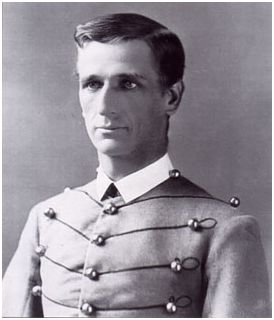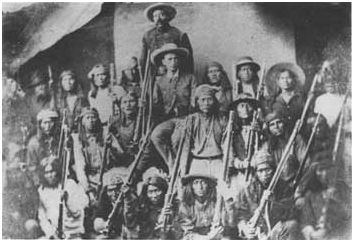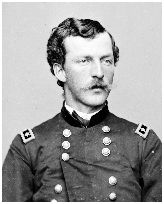Men in History: Charles Gatewood
by Kim Foster
All too frequently people who should be remembered or recognized for their deeds, fall though the cracks of history and land in obscurity. One such individual is Lt. Charles B. Gatewood
 Born into a military family in Virginia in 1853, Gatewood graduated from West Point and served in the 6th calvary. He led companies of Apache and Navaho scouts through out the south west. Gatewood said his success with the scouts depended on two things. Understanding their ways and gaining and keeping their trust.
Born into a military family in Virginia in 1853, Gatewood graduated from West Point and served in the 6th calvary. He led companies of Apache and Navaho scouts through out the south west. Gatewood said his success with the scouts depended on two things. Understanding their ways and gaining and keeping their trust.
Because of his success with his scouts in Arizona, Gatewood was sent to New Mexico in 1879 to capture the Apache chief Victorio. Although he skirmished with Victorio’s men several times, he was unable to capture the chief. In May 1881 he returned to Virginia on sick leave because he had developed rheumatism from exposure to the elements in his years working with the Apache scouts in the harsh Southwest. There, he married Georgia McCulloh, the niece of Richard McCulloh, a prominent engineer and professor at the Washington and Lee university. Gatewood returned to the Southwest on September 17, 1881 under the command of Colonel Carr in his campaign against the Cibecue and White Mountain Apaches.
In 1882, the US Army sent Brigadier General George Crook to take command of Indian operations in Arizona Territory. Crook was an experienced Indian fighter who had long since learned that regular soldiers were almost useless against the Apaches and had based his entire
strategy on employing "Indians to fight other Indians”. Crook’s problem was not rounding up the Apache bands, but keeping them on reservation land. No sooner would he convince one band to stay on the reservation, when another band would leave. The general compared it to carrying water in a leaky bucket. Knowing Gatewood's reputation as one of the army's "Best Apache Men", Crook made him Commandant of the White Mountain Indian Reservation. Although they disagreed on some Indian matters, Crook held Gatewood in high regard. Still unable to solve his leaky bucket problem, Crook resigned his position and retired in 1885. (Photo below: Gatewood with his Apache scouts)
Crook was replaced by General Nelson  Miles. Miles and Crook were as different as night and day. Where Crook tried to do what was best for everyone, even the Apache, Miles was only interested in his own career. For some reason that has been lost to time, if it ever existed at all, Miles deeply despised George Crook and his “fight Indians with Indians” tactics. He even extended this hatred to Crook’s remaining officers and senior enlisted. Even years later, he was known to refer to anyone who had served under Crook as a “Crook man”. As soon as he took command, he had as many of Crook’s officers as he could transferred to menial assignments and replaced them with his own people. He also greatly decreased reliance on Indian scouts. After several months of poor results, Miles saw that he was no further ahead in his mission to capture Geronimo and pacify the Apache than Crook had been. Miles knew that Gatewood was well known to Geronimo, spoke some Apache, and was familiar with their traditions and values, having spent nearly 10 years in the field with them and against them. Gatewood was dispatched by General Miles to seek out Geronimo and offer him a deal to entice him to come in.
Miles. Miles and Crook were as different as night and day. Where Crook tried to do what was best for everyone, even the Apache, Miles was only interested in his own career. For some reason that has been lost to time, if it ever existed at all, Miles deeply despised George Crook and his “fight Indians with Indians” tactics. He even extended this hatred to Crook’s remaining officers and senior enlisted. Even years later, he was known to refer to anyone who had served under Crook as a “Crook man”. As soon as he took command, he had as many of Crook’s officers as he could transferred to menial assignments and replaced them with his own people. He also greatly decreased reliance on Indian scouts. After several months of poor results, Miles saw that he was no further ahead in his mission to capture Geronimo and pacify the Apache than Crook had been. Miles knew that Gatewood was well known to Geronimo, spoke some Apache, and was familiar with their traditions and values, having spent nearly 10 years in the field with them and against them. Gatewood was dispatched by General Miles to seek out Geronimo and offer him a deal to entice him to come in.
 Miles arrived the next day and Geronimo formally surrendered for the fourth and final time on September 4. At the conclusion of the surrender, Geronimo turned to Gatewood and said to him, in Apache, "Good. You told the truth".
Miles arrived the next day and Geronimo formally surrendered for the fourth and final time on September 4. At the conclusion of the surrender, Geronimo turned to Gatewood and said to him, in Apache, "Good. You told the truth".
You would assume that Gen Miles (photo at right) would have been happy to reward and praise Gatewood for effecting the bloodless surrender of the great Geronimo, but that was not the case. Instead he publicly berated him for approaching Geronimo’s camp with only 6 men instead of the complement of 25 that his orders had stated. The same day that the Apache’s train left for Florida, Miles had Gatewood transferred to Ft Stanton NM in an unveiled effort to hog the “Geronimo glory” for himself. However, a week later Gen. Miles learned that Gatewood was being approached by newspapermen to tell about Geronimo’s capture. He had Gatewood recalled and made him his aid de-camp to keep him under his thumb. This deteriorated into an adversarial relationship between the two officers. Gen Miles went so far as to attempt to court martial Gatewood for trivialities but was unable to find another officer that would sign a complaint. In 1890, Gatewood was transfered to South Dakota. For many years after, Miles downplayed Gatewood's role in Geronimo's surrender at every opportunity. Making statements like “He only did his duty. I’m the one that put them on the train to Florida”.
The South Dakota cold greatly contributed to Gatewood’s failing health, a fact that Miles surely would have known, and Gatewood spent much time on sick leave at Hot Springs SD.
By Sept ‘91, Gatewood had recovered sufficiently to be re-posted to Wyoming, where he participated in quelling the Johnson County Range War. There are conflicting reports as to the circumstances, but on May 18, 1892 Gatewood was responding to a fire and was caught in an explosion. His left arm was shattered and he was badly burned. Rendering him too disabled to serve in the Cavalry. Gatewood spent some time convalescing in Denver and then returned to Va.
In 1895 Nelson Miles acquiesced to pressure from other officers and submitted Gatewood for the CMH for his capture of Geronimo. However, it was denied in Washington because Gatewood had not come under fire during the action.
In 1896, while awaiting a medical retirement, his health further declined. He went to Ft Monroe where he was diagnosed with stomach cancer and died on May 20. He was only 43 years old.
In an Army memo advising of the passing of Lt. Gatewood, a Colonel who had known him in Arizona wrote “Too much cannot be said in honor of this brave officer and it is lamentable that he should have died with only the rank of a Lieutenant, after his brilliant services to the Government.”
Despite the Army’s failure to praise or promote Charles, his son chose to follow in his father’s footsteps. Young Gatewood served with distinction in WWI and rose to the rank of Colonel.

Uploaded: 10/30/2014

